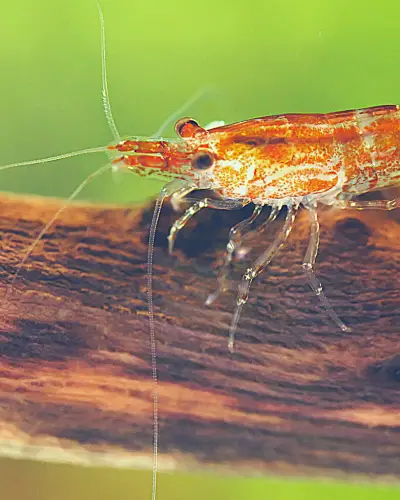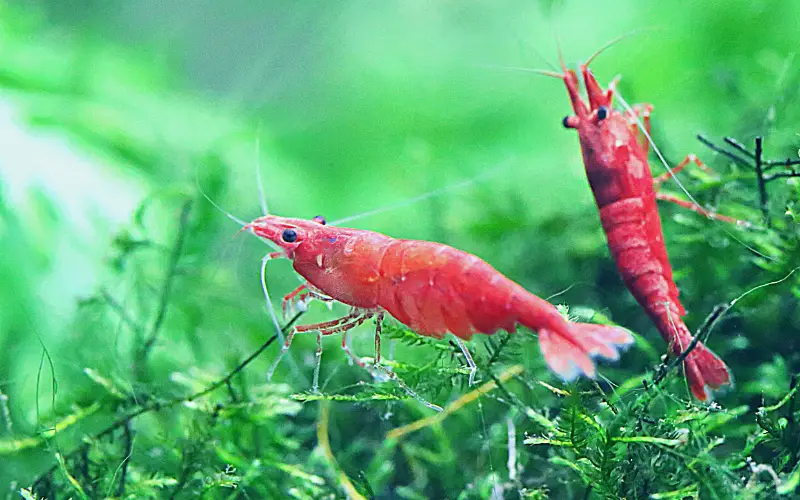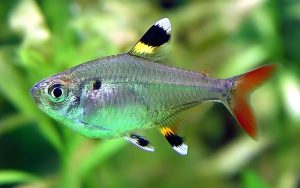If you’re a shrimp enthusiast or a beginner in aquatics, you might have stumbled upon the question: “Do cherry shrimp need a filter?”
It’s a question that deserves attention, as the well-being of these tiny aquatic creatures depends on the environment they’re kept in.
In this article, we’ll investigate whether cherry shrimp need a filter for their tank and uncover the potential pitfalls of neglecting filtration.

Whether you’re a seasoned aquarist or a novice shrimp keeper, let’s explore the ins and outs of this crucial aspect of shrimp care.
Table of Contents
ToggleDo Cherry Shrimp Need a Filter in Their Tank?
Do red cherry shrimp need a filter? Yes, Cherry Shrimp generally benefit from having a filter in their tank. While they are relatively hardy and can tolerate various water conditions, a filter helps maintain optimal water quality for their well-being.
Filters assist in removing excess waste, uneaten food, and harmful toxins, preventing the water from becoming stagnant and polluted. Additionally, filters aid in oxygenating the water, which is crucial for the shrimp’s respiration and overall health.

A sponge or a gentle filter is recommended to prevent the shrimplets from being sucked into the filter system.
Regular maintenance, such as cleaning or replacing filter media, ensures efficient filtration. A filter contributes to a stable and healthy aquatic environment, benefiting the Cherry Shrimp’s longevity and vitality.
Understanding the Importance of Filtration in a Shrimp Tank
Why Filtration Matters for Shrimp Tanks
Why do you need a filter for cherry shrimp? The role of filtration in an aquarium, particularly one housing delicate creatures like cherry shrimp, cannot be overstated.
Filters serve as the lifeline of an aquatic ecosystem, performing essential functions that contribute to water quality and overall shrimp health. Shrimps thrive in well-balanced environments in the wild, and replicating these conditions in a tank is paramount to their well-being.
The Role of Filters in Maintaining Water Quality
Filters play a necessary role in maintaining the water quality of a shrimp tank. They aid in removing debris, excess food, and waste products, thereby preventing the accumulation of harmful substances. Ammonia and nitrite, which are toxic to shrimp, can build up quickly in an unfiltered tank, posing a serious threat to their survival.
Mechanical and Biological Filtration
Various types of filters are available, each employing different mechanisms to keep the water clean. Mechanical filtration involves trapping particles and debris, preventing them from clouding the water. Biological filtration, on the other hand, relies on beneficial bacteria that break down harmful compounds into less toxic substances.
The Big Mistake: Aquarium Going Without a Filter
Risks of Not Using a Filter
Imagine placing cherry shrimp in a tank without a filtration system. The consequences could be dire. Without one, the water quality can deteriorate rapidly, increasing ammonia and nitrite levels. These substances are lethal to shrimp, causing stress, illness, and even death. Poor water quality can also hinder molting, a critical process for shrimps’ growth.
Implications for Cherry Shrimp Health
Cherry shrimp, like other shrimp species, are sensitive to environmental changes. A fish tank without proper filtration can become a breeding ground for harmful pathogens and algae blooms.
These conditions can lead to diseases and further stress the shrimp, making them susceptible to infections and reducing their lifespan.
What Type of Filter for Your Shrimp Tank is best?
For your shrimp tank, selecting the right type of filter is crucial to maintaining a healthy environment for your aquatic inhabitants.
Shrimp tanks require efficient filtration to remove waste and ensure optimal water quality. Two common aquarium filters for your shrimp tank are sponge and canister filters.
- Sponge Filter: A sponge filter is an excellent choice for shrimp tanks, especially if you’re keeping small shrimp or delicate species. It draws water through a sponge, providing mechanical and biological filtration. The sponge is a home for beneficial bacteria, essential for breaking down fish waste and maintaining water quality. Sponge filters are gentle and won’t create strong water currents that could stress out your shrimp. They are easy to install, cost-effective, and suitable for freshwater and saltwater shrimp tanks.
- Canister Filter: A canister filter might be a good option if you have a larger tank or plan to keep other small fish alongside your shrimp. Canister filters offer powerful mechanical, chemical, and biological filtration. They can handle higher volumes of water and accommodate various filter media types, allowing you to tailor the filtration system to your tank’s specific needs. However, adjusting the flow rate is important to ensure your shrimp aren’t adversely affected by strong currents.
When selecting a filtration system for your shrimp tank, consider the following factors:
- Tank Size: Choose a filter appropriate for your tank’s size. Make sure the filter’s flow rate matches the tank’s volume. Shrimp tanks typically benefit from gentle water movement, so avoid filters with overly strong currents.
- Biological Filtration: Both sponge and canister filters provide biological filtration by hosting beneficial bacteria. These bacteria help break down ammonia and nitrite, keeping the water safe for your shrimp.
- Species Sensitivity: Some shrimp species are very sensitive to water parameters and flow. Ensure your filter doesn’t create excessive water movement that might stress your shrimp.
- Maintenance: Regular maintenance is significant to keep your filter functioning optimally. Clean or replace filter media to prevent clogs and maintain effective filtration.
- Additional Considerations: If your shrimp tank is heavily planted, the plants contribute to water quality and might affect your filter and air pump choice. Also, consider whether you want to incorporate chemical filtration media (like activated carbon) to improve water clarity.
In summary, sponge and canister filters can be suitable for your shrimp tank. The decision between the two depends on factors such as tank size, species sensitivity, and the presence of other tank inhabitants.
Whichever filter you choose, ensure that it supports a healthy and stable aquatic environment for your shrimp and any other small fish you may have.
The Correct Approach: Choosing the Right Filter
– Selecting the Appropriate Filter Type
When choosing a filter for your shrimp tank, it’s important to consider the specific needs of cherry shrimp. A sponge filter is often recommended for shrimp tanks due to its gentle water flow and minimal impact on shrimp and their environment. Sponge tank filters provide mechanical and biological filtration, making them ideal for maintaining optimal water quality.
– Other Filtration Options
Consider canister or power filters depending on the size and setup of your tank. However, it’s crucial to ensure that the filter you choose doesn’t create strong currents that could harm the shrimp or disturb their habitat.
Do Shrimp Clean Tanks?
Shrimp are commonly known for their role in tank maintenance and cleaning. When it comes to choosing a cleaning crew for your aquarium, shrimp are a popular choice.
These fascinating creatures are experts at scavenging and removing waste from the tank, helping to keep the water clean and clear.
Shrimp have an instinct to consume leftover food, algae, and decaying plant matter, which helps to prevent the growth of hurtful bacteria and keep the tank environment healthy for other aquatic inhabitants.
In addition to their cleaning abilities, shrimp are mesmerizing to watch as they move around the tank, adding a touch of movement and vibrancy to the overall aesthetics of the aquarium. So, shrimp are a great option if you are looking for a natural and efficient way to maintain a clean and beautiful tank.
Which Shrimp Clean Tanks?
Many shrimp types can help to clean tanks. Some of the most popular include:
- Ghost shrimp are small, translucent shrimp that are hardy and easy to care for. They are also very good at scavenging for food and residue, making them a great addition to any freshwater tank.
- Red cherry shrimp are another popular freshwater shrimp species. They are known for their bright red coloration and are relatively easy to care for. Red cherry shrimp are also good at scavenging for food and residue, but they are easier than ghost shrimp.
- Blood red fire shrimp are a more colorful and exotic freshwater shrimp species. They are more challenging to care for than ghost or red cherry shrimp but are still popular for shrimp keepers. Blood red fire shrimp are also good at scavenging for food and detritus.
- Amano shrimp are a type of saltwater shrimp that are also known for their cleaning abilities. They are larger than freshwater shrimp and have a more robust build. Amano shrimp are also good at eating algae, which can be problematic in saltwater tanks.
No matter what type of shrimp you choose, providing them with a properly cycled tank with the right water parameters is important. Shrimp are sensitive to ammonia and nitrite levels, so it is important to do regular water changes and test your water parameters regularly.
In addition to giving a clean tank, you can also help keep your shrimp clean by providing them with enough hiding places and a lot of plants. Shrimp like to have places to hide from predators and to graze on algae.
With proper care, shrimp can be a great addition to any tank and help to keep it clean and healthy.
Here are some additional tips for keeping your shrimp tank clean:
- Feed your shrimp a balanced diet. This will help to prevent them from becoming scavengers and eating algae and other detritus.
- Provide plenty of hiding places. This will help to reduce stress and make your shrimp feel more secure.
- Maintain proper water parameters. This includes keeping the water temperature, pH, and hardness within the recommended ranges.
- Do regular water changes. This will help to take off ammonia and nitrites from the water and keep it clean and healthy for your shrimp.
- Test your water parameters regularly. This will help you to identify any problems early on and take corrective action.
By following these tips, you can help keep your shrimp tank clean and healthy for many years.
Do You Need To Clean the Shrimp Water Tank Even With a Filter?
As a shrimp keeper, it is vital to maintain the cleanliness of your shrimp water tank, even if you have a filtration system in place.
While filters greatly remove debris and waste, more is needed to keep the tank water pristine. Regular water changes are crucial in maintaining optimal water conditions for your shrimp.
Removing a percentage of the old water and replacing it with fresh, conditioned water can eliminate accumulated toxins and ensure a healthy environment for your shrimp.
Additionally, water changes help replenish essential minerals and nutrients necessary for the shrimp’s well-being. Therefore, regular tank maintenance and water changes are required to keep your shrimp healthy and thriving even with a filter.
Will Ghost Shrimp Also Need a Filter?
Ghost shrimp, like other shrimp, also need a filter to keep their tank clean. A filter helps to eliminate any waste products and debris that accumulate in the tank, creating a healthier environment for the shrimp to thrive in.
It ensures that the water quality remains high by removing harmful substances such as ammonia and nitrates. A sponge filter is a good option for ghost shrimp tanks as it is gentle on the shrimp and provides a suitable surface for beneficial bacteria growth.
These bacteria help break down waste and maintain a balanced nitrogen cycle in the tank. By utilizing a filter, ghost shrimp enthusiasts can prolong the life and well-being of their shrimp, creating a visually pleasing and low-maintenance tank.
What Are the Benefits of Having a Filter for My Shrimp?
Here are the benefits of having a filter for your shrimp tank:
- Improves water quality. A filter helps to remove waste, debris, and uneaten food from the water, which can help to stop the buildup of ammonia and nitrates. These chemicals are toxic to shrimp and can cause them to die.
- Maintains water parameters. A filter can help to keep the water temperature, pH, and hardness within the ideal range for shrimp. This is important for their health and well-being.
- Reduces the need for water changes. A filter can help keep the water clean and clear, so you won’t need to change the water as often. This can save you time and money.
- Encourages growth and reproduction. Shrimp are more likely to grow and reproduce in a clean, well-filtered tank.
- Protects shrimp from predators. A filter can help preserve shrimp from predators by creating a current that makes it difficult to catch them.
- Provides oxygen to the water. A filter helps to oxygenate the water, which is essential for shrimp to breathe.
Even though ghost shrimp can live in a tank without a filter, it is not recommended. A filter will help ensure your shrimp have a long and healthy life.
FAQs About Cherry Shrimp Filtration System
Can cherry shrimp survive in a tank without any filtration system?
While they might survive briefly, cherry shrimp’s health and longevity are severely compromised without proper filtration.
What happens if I don’t clean my filter regularly?
A dirty filter can become a source of contamination, impacting water quality and potentially harming your shrimp.
Can I keep cherry shrimp with other fish species in a filtered tank?
Yes, but choosing compatible fish species is important, ensuring the filter’s water flow is manageable for the shrimp.
How often should I change the water in my shrimp tank with a filter?
Regular water changes, typically around 10-20% weekly, are recommended to maintain optimal water parameters.
Are there any alternatives to traditional filters for shrimp tanks?
Some aquarists use heavily planted tanks for natural filtration, which requires careful balance and monitoring.
What type of filter should I use for my Cherry Shrimp tank?
It is recommended to use a sponge filter for your Cherry Shrimp tank.
Why is a sponge filter recommended for Cherry Shrimp?
A sponge filter is recommended for Cherry Shrimp because it provides gentle filtration and prevents shrimp from getting sucked into the filter.
Can Cherry Shrimp live without a filter?
While Cherry Shrimp can survive without a filter, it is not recommended. A filter helps maintain water quality and provides the necessary oxygen for the shrimp to thrive.
What happens if I don’t use a filter for my Cherry Shrimp tank?
If you don’t use a filter, the water quality may deteriorate, and the shrimp won’t have enough oxygen, leading to stress and health issues.
How often do I need to clean the filter in my Cherry Shrimp tank?
It is suggested to clean the filter every 2-4 weeks, depending on the amount of debris and waste accumulated.
How do I install a filter in my Cherry Shrimp tank?
Place the sponge filter inside the tank and connect it to an air pump to install a filter. Ensure the filter is securely attached, and the air pump provides enough oxygenation.
Can I change the tank water without removing the filter?
Yes, you can change the tank water without removing the filter. Siphon out the excess water while being careful not to disturb the filter.
Can Cherry Shrimp be kept with fish in the same tank?
Yes, Cherry Shrimp can be kept with certain species of fish, as long as the fish are not aggressive towards the shrimp and the tank provides enough hiding places for the shrimp to feel safe.
Is it possible for shrimp to suffocate in a tank without a proper filter?
Yes, shrimp can suffocate if the tank does not have a proper filter. A filter helps maintain oxygen levels in the water, which is crucial for the shrimp’s survival.
Can shrimp live in Walstad tank?
Yes, shrimp can thrive in a Walstad tank. The Walstad method, which combines a soil substrate and live plants, creates a balanced ecosystem that provides natural filtration and food sources for shrimp, making it an ideal environment for their growth and well-being.
Final Thoughts
So, do cherry shrimp need a filter? In conclusion, whether cherry shrimp need a filter is answered with a yes. Providing a well-maintained and balanced environment is essential for the health and vibrancy of your cherry shrimp. Choosing the right filtration system and regularly maintaining it will ensure your aquatic companions’ long and happy lives.
You might also like
- Do Cherry Shrimp Need a Heater: Truth Will Save Your Shrimp!
- How Many Cherry Shrimp Per Gallon: (A Comprehensive Guide)
- Pregnant Cherry Shrimp: 3 Easy Secrets to Healthy Babies!
- What Do Cherry Shrimp Eat: 7 Astonishing Foods They Crave!
- Shrimp Breeding Tank 101 (Setup, Size, Mates & Requirements)
- Keeping Shrimps as Pets: 5 Proven Hacks for Stunning Aquarium
- How Often Do Cherry Shrimp Molt: A Comprehensive Guide
- How Long Do Cherry Shrimp Live: Shocking Truth Revealed!
- How Big Can Cherry Shrimp Get: (3 Massive Growth Hacks!)
- Does Cherry Shrimp Eat Algae Effectively: The Shocking Truth!
- How Long Does Cherry Shrimp Breed: (A Comprehensive Guide)
- How Many Cherry Shrimp for a 10 Gallon Tank: (Solved)
- Red Cherry Shrimp Lifespan: 3 Ways to Triple Their Years!





